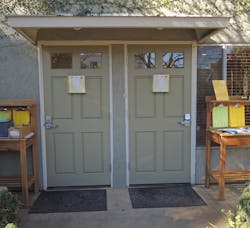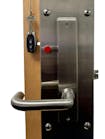A preschool increased the security of its main entry with the installation of a Schlage CO-200-CY-70-MSK offline electromechanical Classroom/Storeroom Function cylindrical lock. The CO-200 replaces one of the two King Cobra KC5100s, which were installed onto the entry doors in early 2005.
The new CO-200 is equipped with a dual credential mag stripe swipe and keypad reader on one of a pair of entry doors to a preschool. The standalone, battery powered KC5100 electromechanical cylindrical lock can accommodate up to 100 three- to eight-digit User Codes and/or iButtons programmed at the lock. The lock is equipped with a manual emergency key override using standard 1-1/8” mortise cylinder.
The preschool is located in a residential neighborhood. The building is surrounded by a six-foot wrought iron fence with a pedestrian gate along the side. Gate security is provided by a deadbolt lock operated in conjunction with an electric strike. Electronic access is controlled using a 12-button digital keypad. The fence and gate restrict entry onto the property, as unauthorized individuals must ring an Annunciator. Policy is an employee of the school meets the person at the gate, further controlling access.
Parents/guardians are provided with a User Code that operates both the electric strike and the electromechanical cylindrical locks, enabling them to bring their children into the school. When the school day is over, they are required to come inside the building to pick up their children. Adding to this the teachers, aids and office personnel, this means the gate keypad and the electromechanical locks are operated at least 100-plus times a day.
To limit parental access to school hours only, a Freeze (Lockout) Code "freezes" the keypad, locking out access and programming codes. The Freeze Code is normally the same length as an access code. When the codes are locked out, re-entering the Freeze Code "unfreezes" the keypad, enabling normal operation. In this case, the administrator enters the Freeze Code at the end of the school day and an employee re-enters the Freeze Code the next school morning, providing parents with access privileges to drop off their children. As an alternative, the software can be used to set time zones and scheduling.
The Schlage CO-200 offline electromechanical lock is configured as Classroom/Storeroom function. Up to 2,000 three- to six-digit credentials can be programmed into the CO-200. This lock can be field -handed. The cylindrical version can accommodate most original equipment manufacturers’ lock cylinders. The lock is available with keypad, Proximity Card or Mag Stripe Card, or a combination of keypad and a card credential. The outside lever is clutched to resist forced operation. The outside lever is always locked. The inside lever always allows egress.
The CO-200 installed is equipped with a Mag Stripe Swipe Reader, which the school is considering using for driver's licenses, to increase the level of security at the door.
The educational facility is in a duplex built in the late 1920s/early 30s, converted to a preschool by the late 1960s. The two six-panel wood front doors have glass lights in the top two panels. LCN pot closers still close the doors. The LCN closers were incorrectly mounted onto the center stile, probably to have sufficient surface area to mount the closers. Over the years, the bent, over long closer arms have slowly cut into the door edge. Nevertheless, they still work.
In the early 2000s, the school installed the King Cobra KC5100 electromechanical cylindrical locks onto the two entry doors. One of the locks was beginning to have some problems and the decision was made to replace it. This King Cobra model was discontinued in 2008. The decision was made to continue with Schlage electromechanical locks.
I was invited to the installation of the Schlage CO-200-CY-70-MSK onto one of the entry doors. Once the King Cobra was removed, we discovered the door was originally prepped to accommodate a 2-3/8" backset cylindrical lock. During the years that followed, the 2-1/8" cross bore opening was enlarged, probably in an attempt to accommodate a 2-3/4" backset commercial lock.
This was not much of a problem for a cylindrical lock as the cross bore was cut out in the stile within the area of the center rail. The problem is the stile is not wide enough to aesthetically accommodate the lock body of the CO-200 with a 2-3/4" backset. However a 2-3/8" deadlatch is available, and the installer had the forethought to bring one.
The problem was the drill jig is designed only for a 2-3/4" backset and was not used for this installation. Instead, the provided template was used. Unfortunately, the cross bore opening was no longer round, making it difficult to determine the correct center point or diameter. This made it difficult to locate the template. Even by looking through the cross bore opening from the inside of the door, it was not easy to determine the correct location for the three drilled openings, the wiring harness and two mounting screws.
The 2-3/8" deadlatch and the retractor were installed into the door.
The arrow stamped into spindle mechanism of the outside assembly must be aligned. Once aligned, the spindle was inserted into the mechanism.
Next, the outside assembly was slid onto the door. The wiring harness was run through the middle drilled hole and the spindle was inserted into the retractor. The plate was placed onto the inside of the door and the two Phillips Head mounting screws were started.
Properly fitting the CO-200 required additional time, causing the installation to require about one hour. A good way to check to be certain a cylindrical lock is properly mounted is the latch should pop out smoothly when depressed or when the lever retracts it. An easy way to implement test is once the outside assembly has been mounted, insert the tip of a Phillips Head Screwdriver into the outside spindle and turn the mechanism. The deadlatch must retract easily and pop back out immediately when rotational pressure has been removed.
If there is any hesitation, there is binding between the latch and the retractor. The problem with an oversized crossbore opening for cylindrical lock with a separate retractor is usually the mounting/wiring holes are out of alignment, either too high or not high enough. Once the three holes were adjusted, the latch operated smoothly lock installation was continued.
The spindle, spring and hub were inserted into the inside spindle body/spring cage. Lock operation was tested by placing the lever onto the spindle shaft.
Next wiring harness was slid through the inside assembly and the inside assembly was mounted using the two provided Phillips Head screws. The wiring harness was connected.
We made sure the driver was vertical (parallel with the bible). Then we determined the positioning of the lock cylinder and installed the outside lever. The mechanical operation of the lock was tested.
The battery pack was installed and the wires were connected.
Schlage CO-200 locks have a default programming code of 97531*. All of the locks have a default User Code of 13579#. The electronic operation should be tested using this User Code. Enter 13579# to verify access. The Schlage logo indicator will blink green, a beep will sound, and the latch will retract when the outside lever is pressed.
The default programming code should be changed to a different five-digit code. Once, changed the administrator was shown how to setup a Program Code, User Code and Freeze Code. She was given the User Guide.
The Schlage CO-200 Series Electromechanical Locks provide educational facilities with the ability to better control access for offline applications.
For more info, contact your local locksmith distributor or Schlage Lock Company, Web Site: www.allegion.com.






